International Marketing Analysis and Strategies for Malmaison Hotel
VerifiedAdded on 2020/04/21
|31
|6255
|53
Report
AI Summary
This report provides a comprehensive analysis of Malmaison Hotel's international marketing strategies. It begins with an introduction to the hotel chain and its acquisition by Fraser Hospitality Group, highlighting its focus on luxurious services. The report then delves into a situational analysis, including PESTLE and Porter's Five Forces analyses, evaluating political, economic, social, technological, legal, and environmental factors, as well as the competitive landscape. An examination of the internal and external business environment follows, utilizing the Value Chain Framework and a SWOT analysis to assess strengths, weaknesses, opportunities, and threats. The report explores current marketing practices, market attractiveness, market entry options, and barriers. Strategic frameworks like the Ansoff Matrix and the marketing mix are applied to formulate recommendations. Finally, the report addresses risk factors, risk management, and concludes with recommendations for expanding Malmaison Hotel's business internationally, offering a detailed overview of the hotel's market positioning and strategic considerations for global expansion.
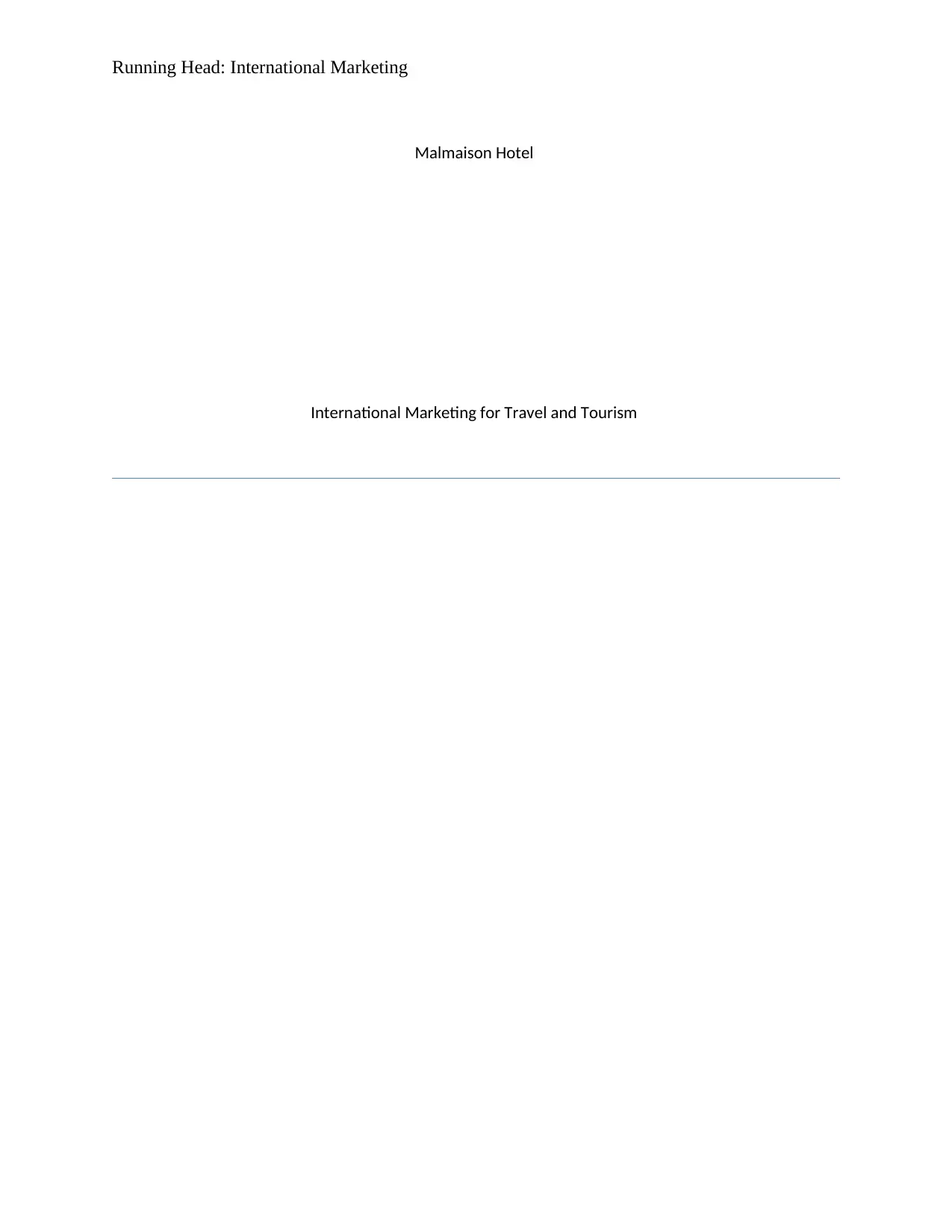
Running Head: International Marketing
Malmaison Hotel
International Marketing for Travel and Tourism
Malmaison Hotel
International Marketing for Travel and Tourism
Paraphrase This Document
Need a fresh take? Get an instant paraphrase of this document with our AI Paraphraser

International Marketing 1
Table of Contents
1.0 Introduction................................................................................................................................2
2.0 Situational Analysis...................................................................................................................4
2.1 Macro Analysis (PESTLE)....................................................................................................4
2.2 Micro Analysis (Porter’s Five Forces)...................................................................................5
3.0 Internal and External Business Environment............................................................................7
3.1 Internal Business Environment of Malmaison Hotel (Value Chain Framework)..................7
3.2 SWOT Analysis.....................................................................................................................9
4.0 Current Marketing practice......................................................................................................10
5.0 Market Attractiveness..............................................................................................................11
Market Selection........................................................................................................................11
Market Entry Options.................................................................................................................12
Barriers to market entry.............................................................................................................13
6.0 Ansoff Matrix Framework.......................................................................................................14
7.0 Marketing Mix Technique.......................................................................................................14
8.0 Evaluation of Risk factors.......................................................................................................16
Management of risk...................................................................................................................16
Conclusion and Recommendations................................................................................................18
References......................................................................................................................................19
Table of Contents
1.0 Introduction................................................................................................................................2
2.0 Situational Analysis...................................................................................................................4
2.1 Macro Analysis (PESTLE)....................................................................................................4
2.2 Micro Analysis (Porter’s Five Forces)...................................................................................5
3.0 Internal and External Business Environment............................................................................7
3.1 Internal Business Environment of Malmaison Hotel (Value Chain Framework)..................7
3.2 SWOT Analysis.....................................................................................................................9
4.0 Current Marketing practice......................................................................................................10
5.0 Market Attractiveness..............................................................................................................11
Market Selection........................................................................................................................11
Market Entry Options.................................................................................................................12
Barriers to market entry.............................................................................................................13
6.0 Ansoff Matrix Framework.......................................................................................................14
7.0 Marketing Mix Technique.......................................................................................................14
8.0 Evaluation of Risk factors.......................................................................................................16
Management of risk...................................................................................................................16
Conclusion and Recommendations................................................................................................18
References......................................................................................................................................19
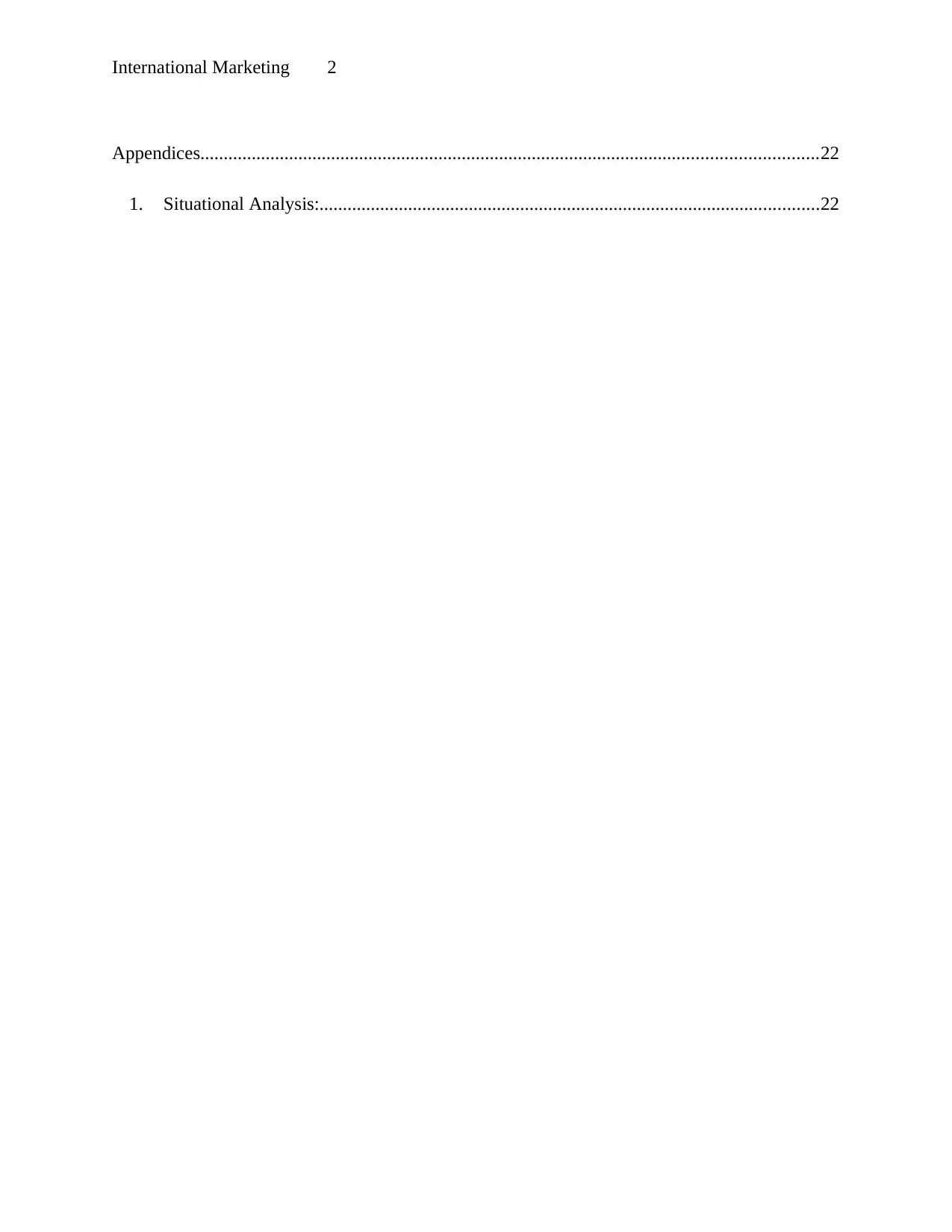
International Marketing 2
Appendices....................................................................................................................................22
1. Situational Analysis:...........................................................................................................22
Appendices....................................................................................................................................22
1. Situational Analysis:...........................................................................................................22
⊘ This is a preview!⊘
Do you want full access?
Subscribe today to unlock all pages.

Trusted by 1+ million students worldwide

International Marketing 3
1.0 Introduction
Malmaison is chain of luxurious hotels and their first hotel was founded in 1994 with the
collaboration of Arcadian International Hotel Group. In 2015, Fraser Hospitality Group
purchased the chain of Malmaison Hotels along with HDV chain (Hotel du Vin) at £363.4
million (Malmaison, 2017). Malmaison Hotel has made their effective image in the hospitality
industry through delivering luxurious and world class services to its guests. With regards to this,
Malmaison Hotel chain is known as the one of the leading brand in the overseas hospitality
industry. Under the name of Malmaison Hotel group, award winning serviced apartments,
boutique lifestyle hotels and hotel residences are included which are the major quality factors of
the organization as well as they are the primary factors of the organization in order to attain the
competitive advantage. Fraser Hospitality Group has enhanced their capabilities in order to
provide luxurious and gold standard services to its customers in Europe, Southeast Asia,
Australia and Middle East, Africa and North Asia. With the help of advanced techniques and
disruptive innovative strategies, Fraser Group attained the peak position in the hospitality
industry across the globe.
Under this report, Malmaison Hotel’s analysis will be conducted in order to evaluate the factors
for expanding the business in the other parts of the world. Currently this hotel is present in 13
locations of UK and those are included in the boutique hotels categories. For analysing the
factors for expanding the business in the international hospitality industry, situational analysis,
analysis of the internal as well as external business environment will be evaluated. In order to
evaluate these factors, SWOT analysis and the Value Chain Framework will be conducted. Apart
from this, Malmaison Hotel’s current marketing strategies will also be discussed for analysing
1.0 Introduction
Malmaison is chain of luxurious hotels and their first hotel was founded in 1994 with the
collaboration of Arcadian International Hotel Group. In 2015, Fraser Hospitality Group
purchased the chain of Malmaison Hotels along with HDV chain (Hotel du Vin) at £363.4
million (Malmaison, 2017). Malmaison Hotel has made their effective image in the hospitality
industry through delivering luxurious and world class services to its guests. With regards to this,
Malmaison Hotel chain is known as the one of the leading brand in the overseas hospitality
industry. Under the name of Malmaison Hotel group, award winning serviced apartments,
boutique lifestyle hotels and hotel residences are included which are the major quality factors of
the organization as well as they are the primary factors of the organization in order to attain the
competitive advantage. Fraser Hospitality Group has enhanced their capabilities in order to
provide luxurious and gold standard services to its customers in Europe, Southeast Asia,
Australia and Middle East, Africa and North Asia. With the help of advanced techniques and
disruptive innovative strategies, Fraser Group attained the peak position in the hospitality
industry across the globe.
Under this report, Malmaison Hotel’s analysis will be conducted in order to evaluate the factors
for expanding the business in the other parts of the world. Currently this hotel is present in 13
locations of UK and those are included in the boutique hotels categories. For analysing the
factors for expanding the business in the international hospitality industry, situational analysis,
analysis of the internal as well as external business environment will be evaluated. In order to
evaluate these factors, SWOT analysis and the Value Chain Framework will be conducted. Apart
from this, Malmaison Hotel’s current marketing strategies will also be discussed for analysing
Paraphrase This Document
Need a fresh take? Get an instant paraphrase of this document with our AI Paraphraser
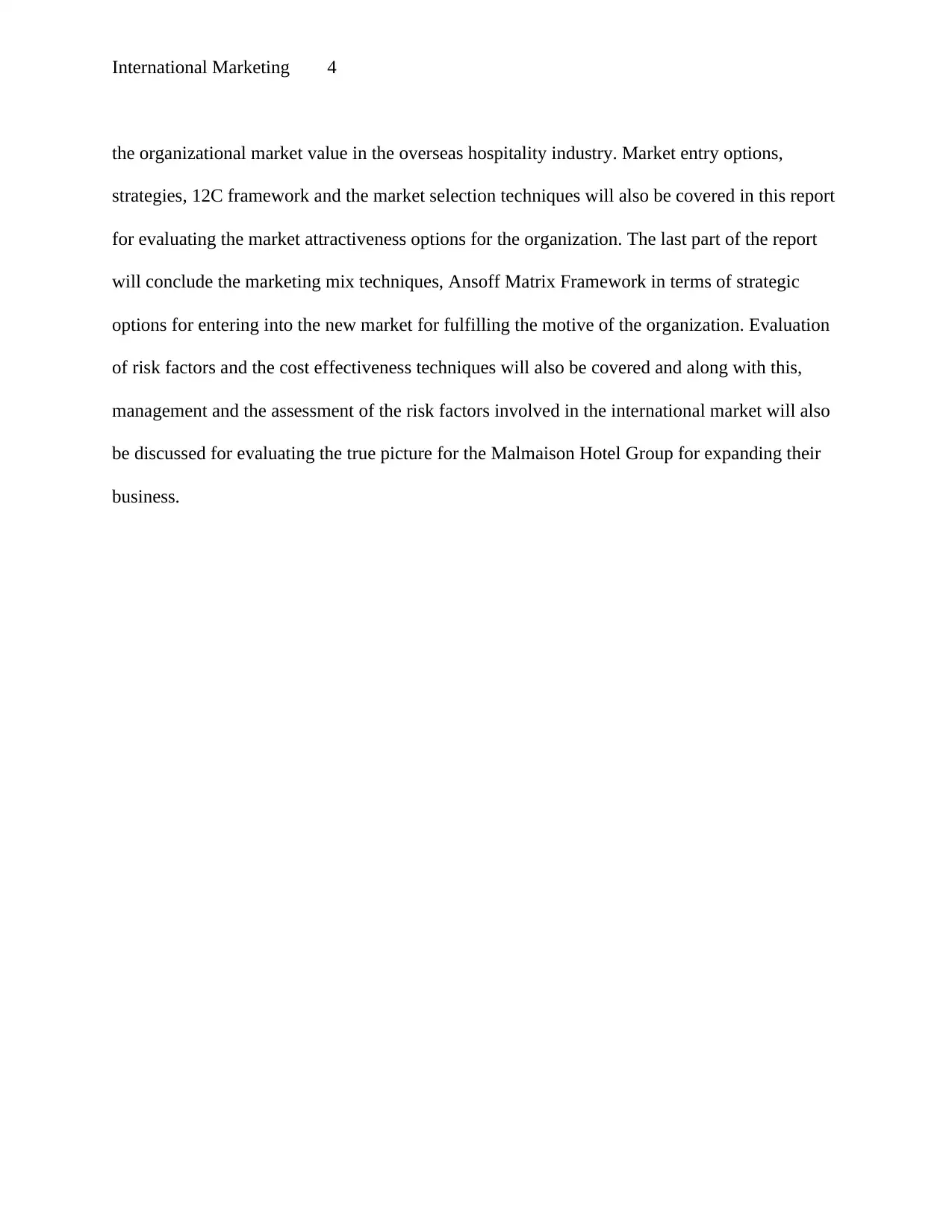
International Marketing 4
the organizational market value in the overseas hospitality industry. Market entry options,
strategies, 12C framework and the market selection techniques will also be covered in this report
for evaluating the market attractiveness options for the organization. The last part of the report
will conclude the marketing mix techniques, Ansoff Matrix Framework in terms of strategic
options for entering into the new market for fulfilling the motive of the organization. Evaluation
of risk factors and the cost effectiveness techniques will also be covered and along with this,
management and the assessment of the risk factors involved in the international market will also
be discussed for evaluating the true picture for the Malmaison Hotel Group for expanding their
business.
the organizational market value in the overseas hospitality industry. Market entry options,
strategies, 12C framework and the market selection techniques will also be covered in this report
for evaluating the market attractiveness options for the organization. The last part of the report
will conclude the marketing mix techniques, Ansoff Matrix Framework in terms of strategic
options for entering into the new market for fulfilling the motive of the organization. Evaluation
of risk factors and the cost effectiveness techniques will also be covered and along with this,
management and the assessment of the risk factors involved in the international market will also
be discussed for evaluating the true picture for the Malmaison Hotel Group for expanding their
business.

International Marketing 5
2.0 Situational Analysis
2.1 Macro Analysis (PESTLE)
Political: Primary objective of the hospitality industry is to attract the tourism from the
international markets through providing them world class qualitative services. Hotel
industry is the major source of income for every country and in order to maintain the
consistency, government authorities develops various policies and the regulations in
order to generate income in the form of tax collections from the international tourism.
Political factors will directly affect the performance of the hotel industry. Thus,
governments build supportive strategies in order to enhance their revenues (Aggett,
2007).
Economic: This includes economic conditions, inflation rate, growth rate, etc. In terms of
global hospitality industry, small change in the economic factors will create big impact.
This is the reason, hotels and other parts of the hospitality industries are promoted on the
regular basis in order to attract the tourism, unique measures are being adopted
(Cornelissen & Cornelissen, 2017).
Social: These factors impact the demand of the services and the products. Hospitality
industry attracts the international tourism through adopting the strategies such as making
available the services which are in regular demand as well as through fulfilling the unique
demands of their guests. This makes the positive image in the guests for global
hospitality industry.
Technological: Technological factors have huge impact over the performance of the
global hospitality industry in various aspects. With the changing customer needs and
2.0 Situational Analysis
2.1 Macro Analysis (PESTLE)
Political: Primary objective of the hospitality industry is to attract the tourism from the
international markets through providing them world class qualitative services. Hotel
industry is the major source of income for every country and in order to maintain the
consistency, government authorities develops various policies and the regulations in
order to generate income in the form of tax collections from the international tourism.
Political factors will directly affect the performance of the hotel industry. Thus,
governments build supportive strategies in order to enhance their revenues (Aggett,
2007).
Economic: This includes economic conditions, inflation rate, growth rate, etc. In terms of
global hospitality industry, small change in the economic factors will create big impact.
This is the reason, hotels and other parts of the hospitality industries are promoted on the
regular basis in order to attract the tourism, unique measures are being adopted
(Cornelissen & Cornelissen, 2017).
Social: These factors impact the demand of the services and the products. Hospitality
industry attracts the international tourism through adopting the strategies such as making
available the services which are in regular demand as well as through fulfilling the unique
demands of their guests. This makes the positive image in the guests for global
hospitality industry.
Technological: Technological factors have huge impact over the performance of the
global hospitality industry in various aspects. With the changing customer needs and
⊘ This is a preview!⊘
Do you want full access?
Subscribe today to unlock all pages.

Trusted by 1+ million students worldwide
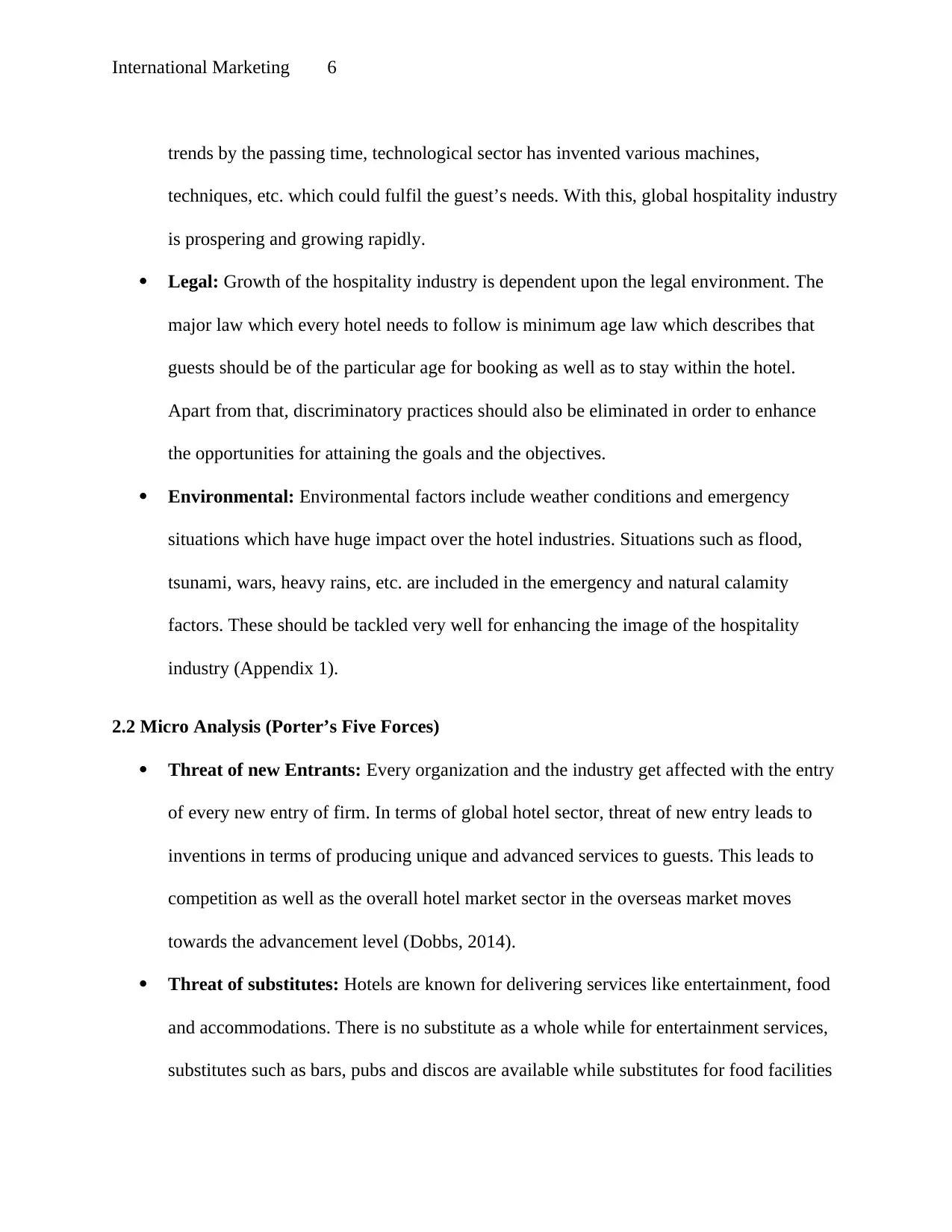
International Marketing 6
trends by the passing time, technological sector has invented various machines,
techniques, etc. which could fulfil the guest’s needs. With this, global hospitality industry
is prospering and growing rapidly.
Legal: Growth of the hospitality industry is dependent upon the legal environment. The
major law which every hotel needs to follow is minimum age law which describes that
guests should be of the particular age for booking as well as to stay within the hotel.
Apart from that, discriminatory practices should also be eliminated in order to enhance
the opportunities for attaining the goals and the objectives.
Environmental: Environmental factors include weather conditions and emergency
situations which have huge impact over the hotel industries. Situations such as flood,
tsunami, wars, heavy rains, etc. are included in the emergency and natural calamity
factors. These should be tackled very well for enhancing the image of the hospitality
industry (Appendix 1).
2.2 Micro Analysis (Porter’s Five Forces)
Threat of new Entrants: Every organization and the industry get affected with the entry
of every new entry of firm. In terms of global hotel sector, threat of new entry leads to
inventions in terms of producing unique and advanced services to guests. This leads to
competition as well as the overall hotel market sector in the overseas market moves
towards the advancement level (Dobbs, 2014).
Threat of substitutes: Hotels are known for delivering services like entertainment, food
and accommodations. There is no substitute as a whole while for entertainment services,
substitutes such as bars, pubs and discos are available while substitutes for food facilities
trends by the passing time, technological sector has invented various machines,
techniques, etc. which could fulfil the guest’s needs. With this, global hospitality industry
is prospering and growing rapidly.
Legal: Growth of the hospitality industry is dependent upon the legal environment. The
major law which every hotel needs to follow is minimum age law which describes that
guests should be of the particular age for booking as well as to stay within the hotel.
Apart from that, discriminatory practices should also be eliminated in order to enhance
the opportunities for attaining the goals and the objectives.
Environmental: Environmental factors include weather conditions and emergency
situations which have huge impact over the hotel industries. Situations such as flood,
tsunami, wars, heavy rains, etc. are included in the emergency and natural calamity
factors. These should be tackled very well for enhancing the image of the hospitality
industry (Appendix 1).
2.2 Micro Analysis (Porter’s Five Forces)
Threat of new Entrants: Every organization and the industry get affected with the entry
of every new entry of firm. In terms of global hotel sector, threat of new entry leads to
inventions in terms of producing unique and advanced services to guests. This leads to
competition as well as the overall hotel market sector in the overseas market moves
towards the advancement level (Dobbs, 2014).
Threat of substitutes: Hotels are known for delivering services like entertainment, food
and accommodations. There is no substitute as a whole while for entertainment services,
substitutes such as bars, pubs and discos are available while substitutes for food facilities
Paraphrase This Document
Need a fresh take? Get an instant paraphrase of this document with our AI Paraphraser
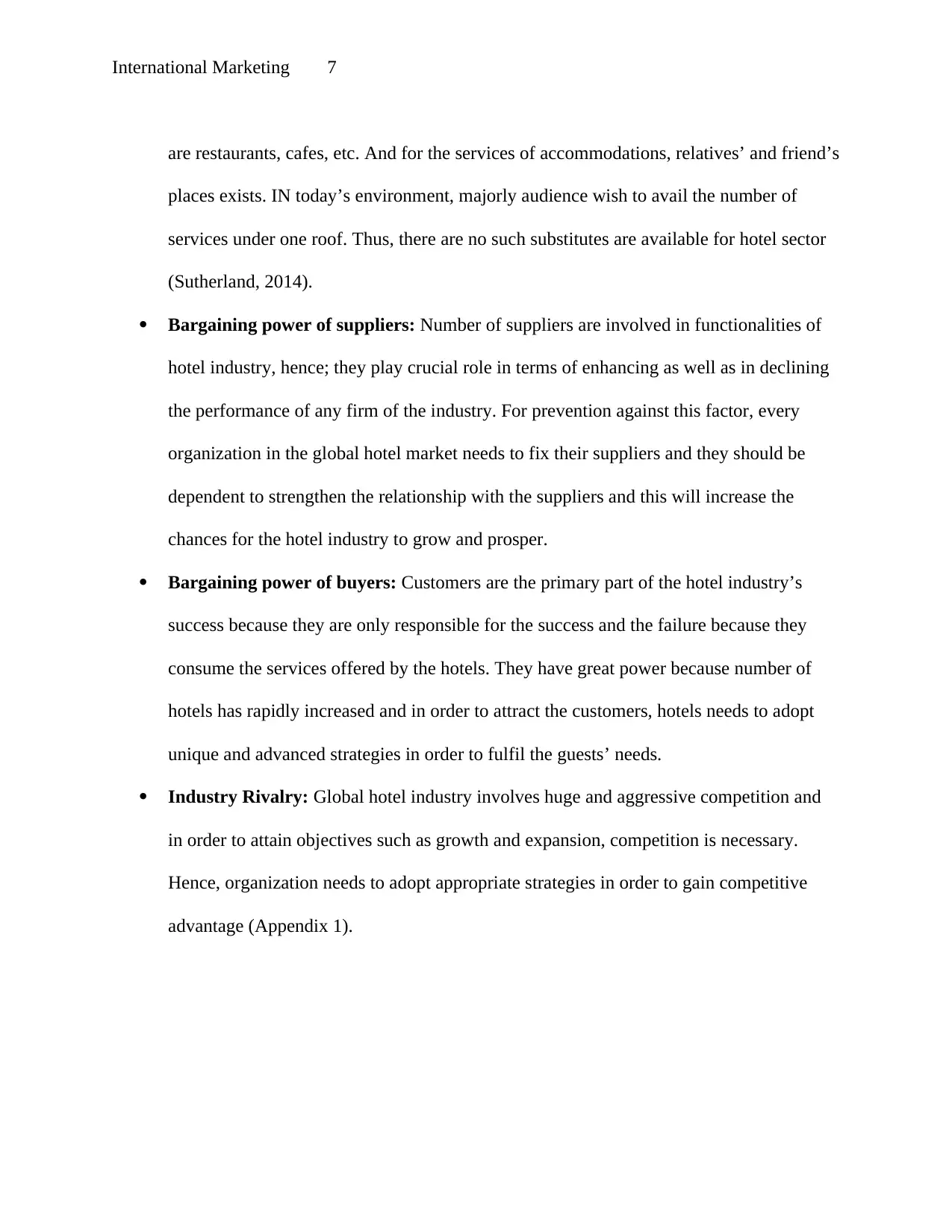
International Marketing 7
are restaurants, cafes, etc. And for the services of accommodations, relatives’ and friend’s
places exists. IN today’s environment, majorly audience wish to avail the number of
services under one roof. Thus, there are no such substitutes are available for hotel sector
(Sutherland, 2014).
Bargaining power of suppliers: Number of suppliers are involved in functionalities of
hotel industry, hence; they play crucial role in terms of enhancing as well as in declining
the performance of any firm of the industry. For prevention against this factor, every
organization in the global hotel market needs to fix their suppliers and they should be
dependent to strengthen the relationship with the suppliers and this will increase the
chances for the hotel industry to grow and prosper.
Bargaining power of buyers: Customers are the primary part of the hotel industry’s
success because they are only responsible for the success and the failure because they
consume the services offered by the hotels. They have great power because number of
hotels has rapidly increased and in order to attract the customers, hotels needs to adopt
unique and advanced strategies in order to fulfil the guests’ needs.
Industry Rivalry: Global hotel industry involves huge and aggressive competition and
in order to attain objectives such as growth and expansion, competition is necessary.
Hence, organization needs to adopt appropriate strategies in order to gain competitive
advantage (Appendix 1).
are restaurants, cafes, etc. And for the services of accommodations, relatives’ and friend’s
places exists. IN today’s environment, majorly audience wish to avail the number of
services under one roof. Thus, there are no such substitutes are available for hotel sector
(Sutherland, 2014).
Bargaining power of suppliers: Number of suppliers are involved in functionalities of
hotel industry, hence; they play crucial role in terms of enhancing as well as in declining
the performance of any firm of the industry. For prevention against this factor, every
organization in the global hotel market needs to fix their suppliers and they should be
dependent to strengthen the relationship with the suppliers and this will increase the
chances for the hotel industry to grow and prosper.
Bargaining power of buyers: Customers are the primary part of the hotel industry’s
success because they are only responsible for the success and the failure because they
consume the services offered by the hotels. They have great power because number of
hotels has rapidly increased and in order to attract the customers, hotels needs to adopt
unique and advanced strategies in order to fulfil the guests’ needs.
Industry Rivalry: Global hotel industry involves huge and aggressive competition and
in order to attain objectives such as growth and expansion, competition is necessary.
Hence, organization needs to adopt appropriate strategies in order to gain competitive
advantage (Appendix 1).
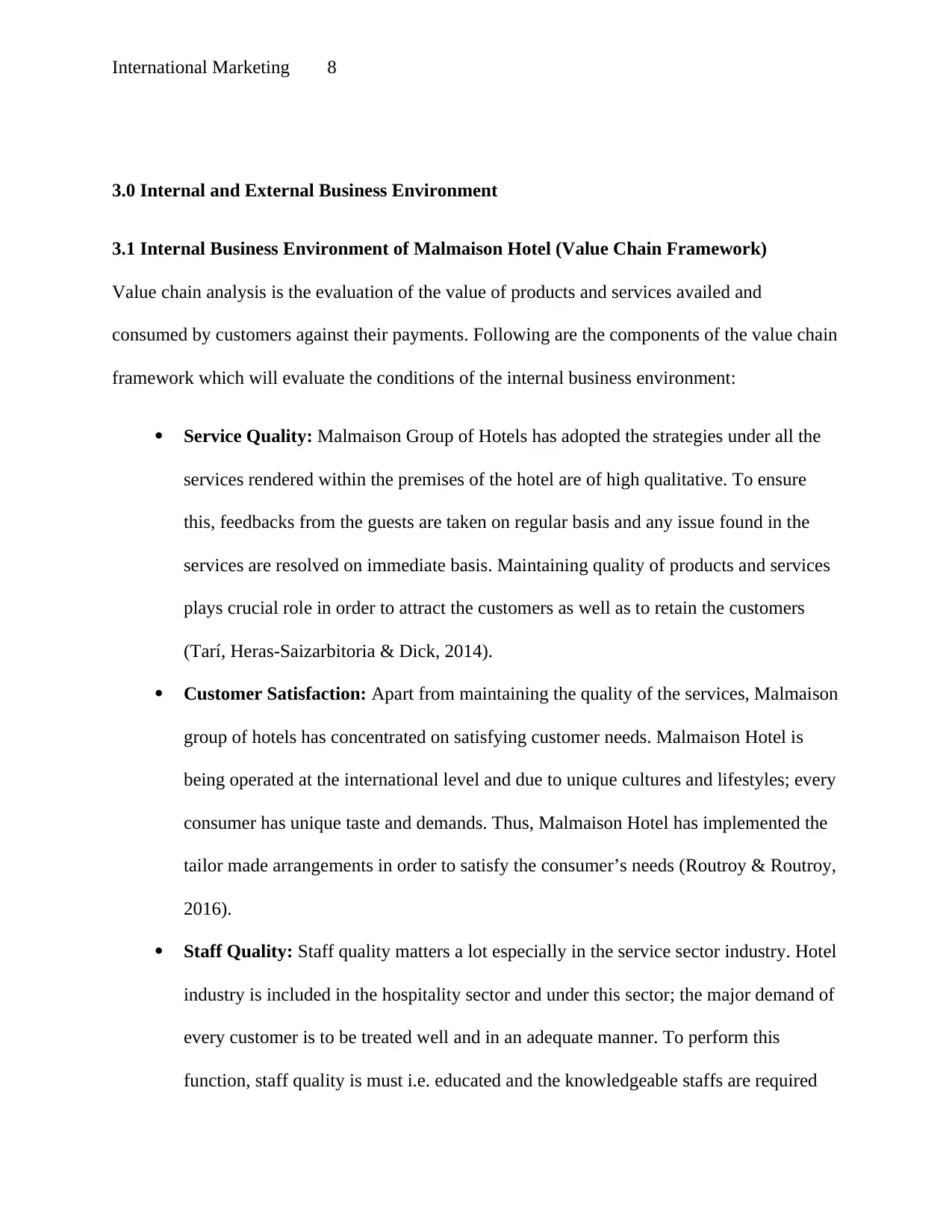
International Marketing 8
3.0 Internal and External Business Environment
3.1 Internal Business Environment of Malmaison Hotel (Value Chain Framework)
Value chain analysis is the evaluation of the value of products and services availed and
consumed by customers against their payments. Following are the components of the value chain
framework which will evaluate the conditions of the internal business environment:
Service Quality: Malmaison Group of Hotels has adopted the strategies under all the
services rendered within the premises of the hotel are of high qualitative. To ensure
this, feedbacks from the guests are taken on regular basis and any issue found in the
services are resolved on immediate basis. Maintaining quality of products and services
plays crucial role in order to attract the customers as well as to retain the customers
(Tarí, Heras-Saizarbitoria & Dick, 2014).
Customer Satisfaction: Apart from maintaining the quality of the services, Malmaison
group of hotels has concentrated on satisfying customer needs. Malmaison Hotel is
being operated at the international level and due to unique cultures and lifestyles; every
consumer has unique taste and demands. Thus, Malmaison Hotel has implemented the
tailor made arrangements in order to satisfy the consumer’s needs (Routroy & Routroy,
2016).
Staff Quality: Staff quality matters a lot especially in the service sector industry. Hotel
industry is included in the hospitality sector and under this sector; the major demand of
every customer is to be treated well and in an adequate manner. To perform this
function, staff quality is must i.e. educated and the knowledgeable staffs are required
3.0 Internal and External Business Environment
3.1 Internal Business Environment of Malmaison Hotel (Value Chain Framework)
Value chain analysis is the evaluation of the value of products and services availed and
consumed by customers against their payments. Following are the components of the value chain
framework which will evaluate the conditions of the internal business environment:
Service Quality: Malmaison Group of Hotels has adopted the strategies under all the
services rendered within the premises of the hotel are of high qualitative. To ensure
this, feedbacks from the guests are taken on regular basis and any issue found in the
services are resolved on immediate basis. Maintaining quality of products and services
plays crucial role in order to attract the customers as well as to retain the customers
(Tarí, Heras-Saizarbitoria & Dick, 2014).
Customer Satisfaction: Apart from maintaining the quality of the services, Malmaison
group of hotels has concentrated on satisfying customer needs. Malmaison Hotel is
being operated at the international level and due to unique cultures and lifestyles; every
consumer has unique taste and demands. Thus, Malmaison Hotel has implemented the
tailor made arrangements in order to satisfy the consumer’s needs (Routroy & Routroy,
2016).
Staff Quality: Staff quality matters a lot especially in the service sector industry. Hotel
industry is included in the hospitality sector and under this sector; the major demand of
every customer is to be treated well and in an adequate manner. To perform this
function, staff quality is must i.e. educated and the knowledgeable staffs are required
⊘ This is a preview!⊘
Do you want full access?
Subscribe today to unlock all pages.

Trusted by 1+ million students worldwide
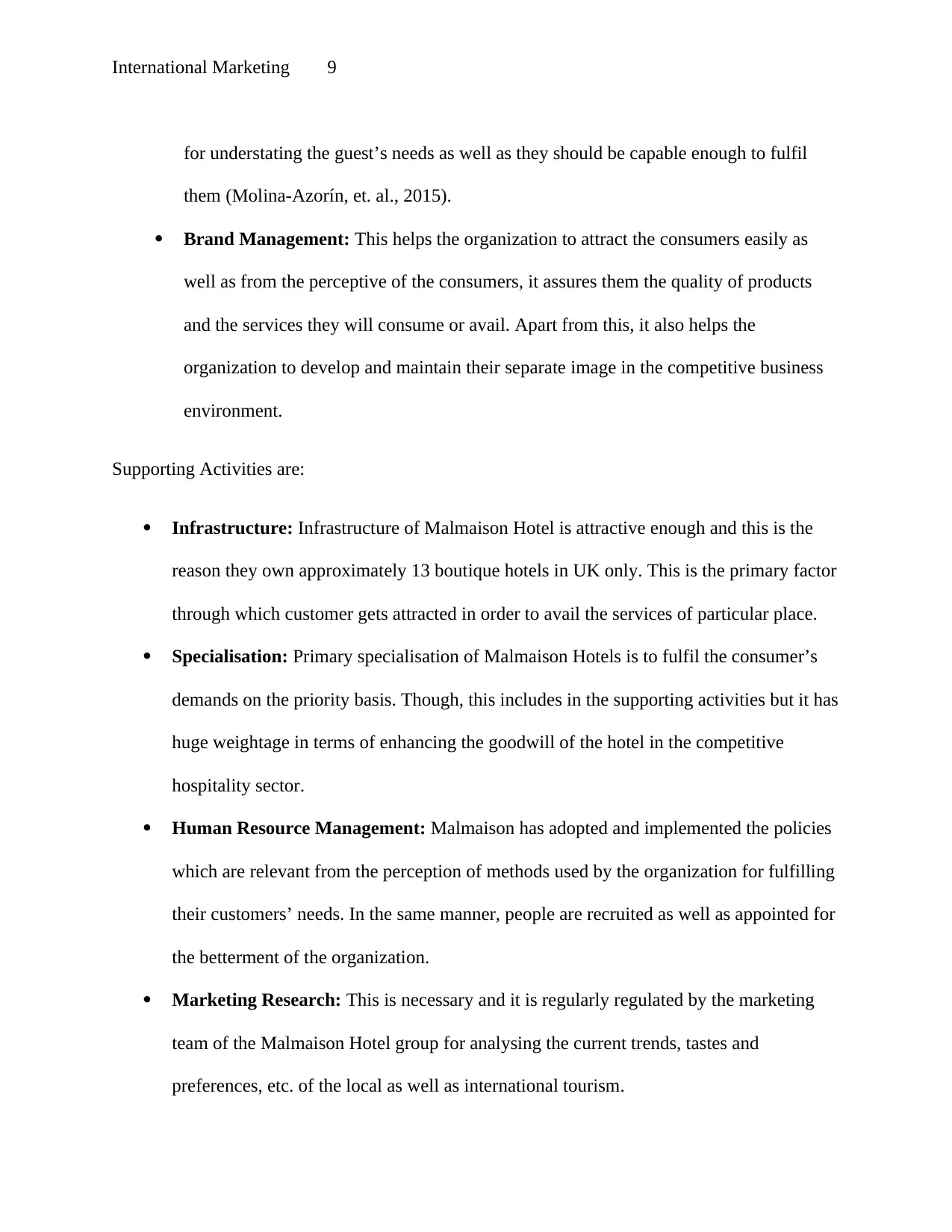
International Marketing 9
for understating the guest’s needs as well as they should be capable enough to fulfil
them (Molina-Azorín, et. al., 2015).
Brand Management: This helps the organization to attract the consumers easily as
well as from the perceptive of the consumers, it assures them the quality of products
and the services they will consume or avail. Apart from this, it also helps the
organization to develop and maintain their separate image in the competitive business
environment.
Supporting Activities are:
Infrastructure: Infrastructure of Malmaison Hotel is attractive enough and this is the
reason they own approximately 13 boutique hotels in UK only. This is the primary factor
through which customer gets attracted in order to avail the services of particular place.
Specialisation: Primary specialisation of Malmaison Hotels is to fulfil the consumer’s
demands on the priority basis. Though, this includes in the supporting activities but it has
huge weightage in terms of enhancing the goodwill of the hotel in the competitive
hospitality sector.
Human Resource Management: Malmaison has adopted and implemented the policies
which are relevant from the perception of methods used by the organization for fulfilling
their customers’ needs. In the same manner, people are recruited as well as appointed for
the betterment of the organization.
Marketing Research: This is necessary and it is regularly regulated by the marketing
team of the Malmaison Hotel group for analysing the current trends, tastes and
preferences, etc. of the local as well as international tourism.
for understating the guest’s needs as well as they should be capable enough to fulfil
them (Molina-Azorín, et. al., 2015).
Brand Management: This helps the organization to attract the consumers easily as
well as from the perceptive of the consumers, it assures them the quality of products
and the services they will consume or avail. Apart from this, it also helps the
organization to develop and maintain their separate image in the competitive business
environment.
Supporting Activities are:
Infrastructure: Infrastructure of Malmaison Hotel is attractive enough and this is the
reason they own approximately 13 boutique hotels in UK only. This is the primary factor
through which customer gets attracted in order to avail the services of particular place.
Specialisation: Primary specialisation of Malmaison Hotels is to fulfil the consumer’s
demands on the priority basis. Though, this includes in the supporting activities but it has
huge weightage in terms of enhancing the goodwill of the hotel in the competitive
hospitality sector.
Human Resource Management: Malmaison has adopted and implemented the policies
which are relevant from the perception of methods used by the organization for fulfilling
their customers’ needs. In the same manner, people are recruited as well as appointed for
the betterment of the organization.
Marketing Research: This is necessary and it is regularly regulated by the marketing
team of the Malmaison Hotel group for analysing the current trends, tastes and
preferences, etc. of the local as well as international tourism.
Paraphrase This Document
Need a fresh take? Get an instant paraphrase of this document with our AI Paraphraser
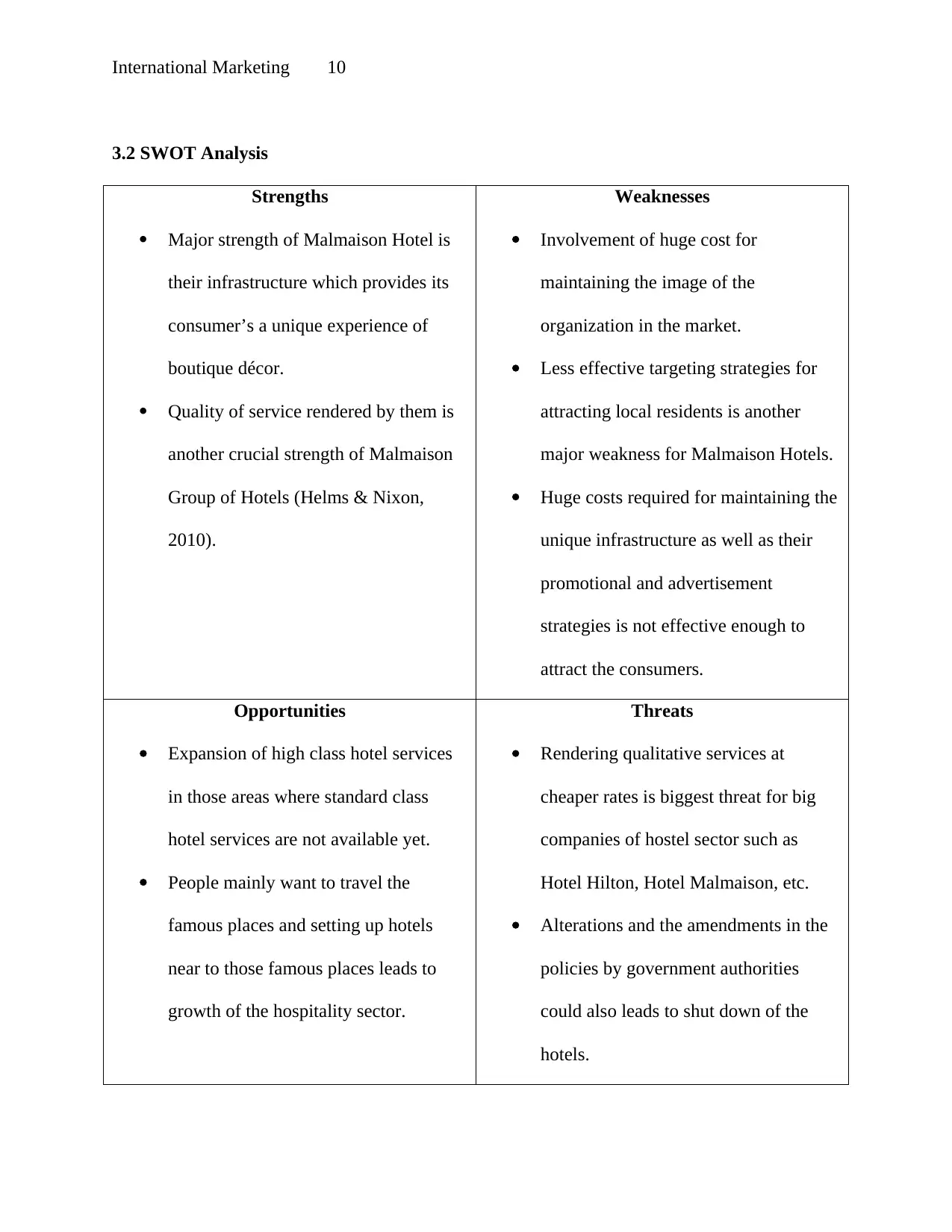
International Marketing 10
3.2 SWOT Analysis
Strengths
Major strength of Malmaison Hotel is
their infrastructure which provides its
consumer’s a unique experience of
boutique décor.
Quality of service rendered by them is
another crucial strength of Malmaison
Group of Hotels (Helms & Nixon,
2010).
Weaknesses
Involvement of huge cost for
maintaining the image of the
organization in the market.
Less effective targeting strategies for
attracting local residents is another
major weakness for Malmaison Hotels.
Huge costs required for maintaining the
unique infrastructure as well as their
promotional and advertisement
strategies is not effective enough to
attract the consumers.
Opportunities
Expansion of high class hotel services
in those areas where standard class
hotel services are not available yet.
People mainly want to travel the
famous places and setting up hotels
near to those famous places leads to
growth of the hospitality sector.
Threats
Rendering qualitative services at
cheaper rates is biggest threat for big
companies of hostel sector such as
Hotel Hilton, Hotel Malmaison, etc.
Alterations and the amendments in the
policies by government authorities
could also leads to shut down of the
hotels.
3.2 SWOT Analysis
Strengths
Major strength of Malmaison Hotel is
their infrastructure which provides its
consumer’s a unique experience of
boutique décor.
Quality of service rendered by them is
another crucial strength of Malmaison
Group of Hotels (Helms & Nixon,
2010).
Weaknesses
Involvement of huge cost for
maintaining the image of the
organization in the market.
Less effective targeting strategies for
attracting local residents is another
major weakness for Malmaison Hotels.
Huge costs required for maintaining the
unique infrastructure as well as their
promotional and advertisement
strategies is not effective enough to
attract the consumers.
Opportunities
Expansion of high class hotel services
in those areas where standard class
hotel services are not available yet.
People mainly want to travel the
famous places and setting up hotels
near to those famous places leads to
growth of the hospitality sector.
Threats
Rendering qualitative services at
cheaper rates is biggest threat for big
companies of hostel sector such as
Hotel Hilton, Hotel Malmaison, etc.
Alterations and the amendments in the
policies by government authorities
could also leads to shut down of the
hotels.
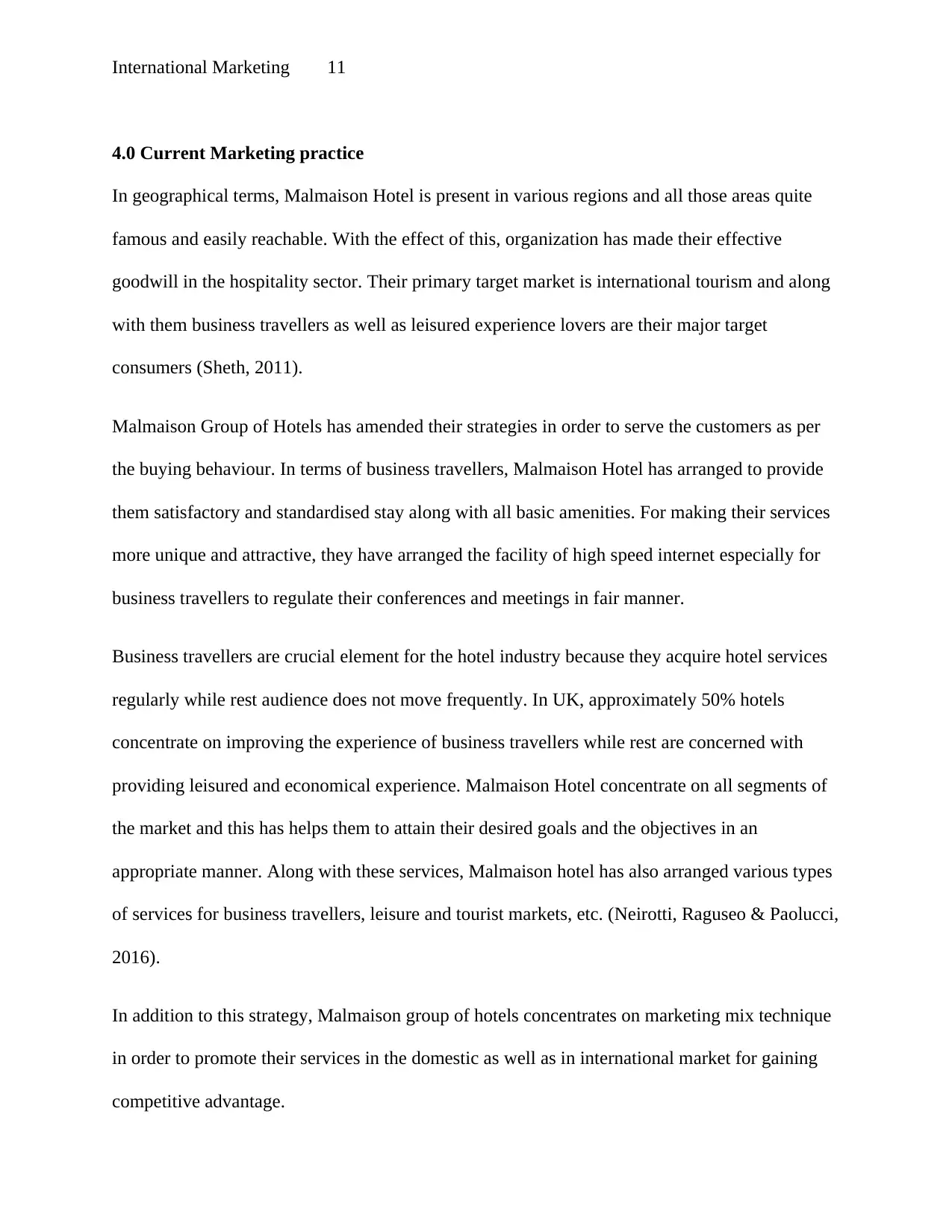
International Marketing 11
4.0 Current Marketing practice
In geographical terms, Malmaison Hotel is present in various regions and all those areas quite
famous and easily reachable. With the effect of this, organization has made their effective
goodwill in the hospitality sector. Their primary target market is international tourism and along
with them business travellers as well as leisured experience lovers are their major target
consumers (Sheth, 2011).
Malmaison Group of Hotels has amended their strategies in order to serve the customers as per
the buying behaviour. In terms of business travellers, Malmaison Hotel has arranged to provide
them satisfactory and standardised stay along with all basic amenities. For making their services
more unique and attractive, they have arranged the facility of high speed internet especially for
business travellers to regulate their conferences and meetings in fair manner.
Business travellers are crucial element for the hotel industry because they acquire hotel services
regularly while rest audience does not move frequently. In UK, approximately 50% hotels
concentrate on improving the experience of business travellers while rest are concerned with
providing leisured and economical experience. Malmaison Hotel concentrate on all segments of
the market and this has helps them to attain their desired goals and the objectives in an
appropriate manner. Along with these services, Malmaison hotel has also arranged various types
of services for business travellers, leisure and tourist markets, etc. (Neirotti, Raguseo & Paolucci,
2016).
In addition to this strategy, Malmaison group of hotels concentrates on marketing mix technique
in order to promote their services in the domestic as well as in international market for gaining
competitive advantage.
4.0 Current Marketing practice
In geographical terms, Malmaison Hotel is present in various regions and all those areas quite
famous and easily reachable. With the effect of this, organization has made their effective
goodwill in the hospitality sector. Their primary target market is international tourism and along
with them business travellers as well as leisured experience lovers are their major target
consumers (Sheth, 2011).
Malmaison Group of Hotels has amended their strategies in order to serve the customers as per
the buying behaviour. In terms of business travellers, Malmaison Hotel has arranged to provide
them satisfactory and standardised stay along with all basic amenities. For making their services
more unique and attractive, they have arranged the facility of high speed internet especially for
business travellers to regulate their conferences and meetings in fair manner.
Business travellers are crucial element for the hotel industry because they acquire hotel services
regularly while rest audience does not move frequently. In UK, approximately 50% hotels
concentrate on improving the experience of business travellers while rest are concerned with
providing leisured and economical experience. Malmaison Hotel concentrate on all segments of
the market and this has helps them to attain their desired goals and the objectives in an
appropriate manner. Along with these services, Malmaison hotel has also arranged various types
of services for business travellers, leisure and tourist markets, etc. (Neirotti, Raguseo & Paolucci,
2016).
In addition to this strategy, Malmaison group of hotels concentrates on marketing mix technique
in order to promote their services in the domestic as well as in international market for gaining
competitive advantage.
⊘ This is a preview!⊘
Do you want full access?
Subscribe today to unlock all pages.

Trusted by 1+ million students worldwide
1 out of 31
Related Documents
Your All-in-One AI-Powered Toolkit for Academic Success.
+13062052269
info@desklib.com
Available 24*7 on WhatsApp / Email
![[object Object]](/_next/static/media/star-bottom.7253800d.svg)
Unlock your academic potential
Copyright © 2020–2025 A2Z Services. All Rights Reserved. Developed and managed by ZUCOL.




